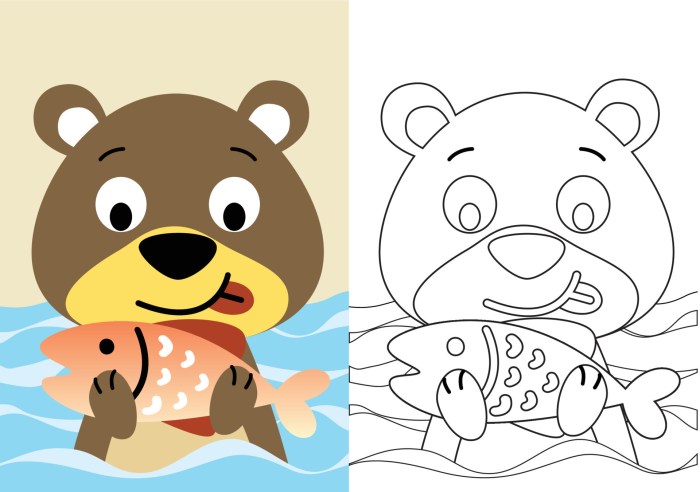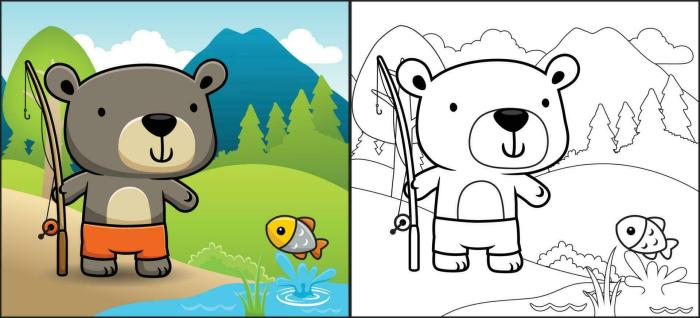Target Audience Identification
Animated bear cub holding fish coloring page – The primary target audience for an animated bear cub holding a fish coloring page consists of young children. This coloring page appeals to a specific demographic due to its inherent visual appeal and simplicity.The age range most likely to engage with this coloring page is approximately 3 to 7 years old. Children within this age group are typically developing fine motor skills, exhibiting a strong interest in animals, and enjoying creative activities like coloring.
Their artistic abilities are generally rudimentary, focusing on expression rather than technical proficiency. They are drawn to bright colors, simple shapes, and recognizable characters.
Target Audience Characteristics, Animated bear cub holding fish coloring page
Children aged 3-7 years old possess a natural curiosity and a penchant for imaginative play. Their interests often center around animals, particularly cute and cuddly ones like bear cubs. The inclusion of a fish adds another element of interest, possibly sparking conversations about nature and underwater life. Their artistic skills are still developing; therefore, the coloring page should feature simple Artikels and large spaces to color, minimizing frustration and maximizing enjoyment.
They may require assistance from adults in coloring within the lines, but the overall process should be engaging and self-directed.
Marketing Strategies
Reaching this target audience requires strategies tailored to parents and caregivers, who are ultimately the decision-makers in purchasing coloring books or printable resources. Marketing efforts should focus on highlighting the educational and entertainment value of the coloring page.Effective marketing strategies include:
- Online platforms: Promoting the coloring page on websites and social media channels frequented by parents, such as parenting blogs, children’s activity websites, and Facebook groups dedicated to early childhood education. Visual advertisements showcasing the cute bear cub and vibrant colors would be highly effective.
- Partnerships with children’s brands: Collaborating with companies that produce children’s toys, books, or educational materials to cross-promote the coloring page. This could involve including a digital download code in their products or featuring the coloring page on their websites.
- Print media: Advertising the coloring page in magazines or newspapers targeted towards parents of young children. This could be a small advertisement with a QR code linking to a downloadable version of the coloring page.
- Educational resource websites: Offering the coloring page as a free download on websites dedicated to providing printable activities for children. This can increase visibility and establish the coloring page as a valuable resource for parents and educators.
Design Elements Exploration

The design of the coloring page will significantly impact its appeal to the target audience. Careful consideration of stylistic choices, pose variations, and background settings is crucial for creating a visually engaging and age-appropriate product. The following sections detail several options for each of these design elements.
Unleash your inner artist with an adorable animated bear cub holding a fish coloring page! It’s a delightful way to explore creativity, and for even more animal-themed fun, check out these charming illustrations at animals reading coloring clip art for inspiration. Then, return to your cheerful bear cub and let your imagination paint a vibrant underwater world around him!
Design Styles
Three distinct design styles are proposed for the coloring page, each catering to different aesthetic preferences: a cartoonish style, a realistic style, and a minimalist style. The cartoonish style would utilize exaggerated features, bright colors, and simplified shapes for a playful and approachable aesthetic. The realistic style would focus on accurate anatomical details and natural color palettes, providing a more detailed and lifelike depiction of the bear cub and its environment.
Finally, the minimalist style would employ simple lines and shapes, limited color palettes, and a focus on negative space to create a clean and modern look. Each style offers a unique visual experience.
Bear Cub Poses
Three distinct poses for the bear cub holding the fish are presented below. The first pose depicts the bear cub sitting upright, proudly displaying its catch with both paws. This pose conveys a sense of accomplishment and joy. The second pose shows the bear cub playfully holding the fish aloft in one paw, its head tilted to one side, creating a more whimsical and engaging image.
This pose suggests a sense of curiosity and playfulness. The third pose portrays the bear cub carefully holding the fish in both paws, its expression serious and focused, suggesting a sense of responsibility and care. This pose offers a more subdued and contemplative mood.
Background Scenarios
Five different background scenarios are proposed to enhance the coloring page’s visual appeal and narrative context. The first scenario is a lush forest clearing, filled with vibrant wildflowers and tall trees. This creates a natural and inviting setting. The second scenario is a tranquil riverside scene, with gently flowing water and lush vegetation. This evokes a peaceful and serene atmosphere.
The third scenario is a playful depiction of a cave, adding a sense of mystery and adventure. The fourth is a simple, uncluttered background of a single, large leaf, which would enhance the minimalist approach. The fifth scenario presents a snowy mountain scene, providing a contrasting colder environment for the bear cub. Each scenario provides a unique backdrop to complement the central image.
Alternative Visual Concepts: Animated Bear Cub Holding Fish Coloring Page

Expanding upon the initial design of a bear cub holding a fish, several alternative visual concepts can enhance the coloring page’s appeal and offer greater creative possibilities for children. These alternatives focus on enriching the scene, introducing new elements, and providing more dynamic interactions for the young artist to engage with.Exploring variations in the coloring page’s central theme allows for a wider range of artistic expression and caters to diverse preferences among young colorists.
The following concepts provide engaging alternatives to the initial design.
Bear Cub Interacting with Other Animals
A coloring page depicting the bear cub interacting with other forest animals offers a more vibrant and engaging scene. The inclusion of additional characters, such as a playful squirrel, a wise old owl, or a curious rabbit, provides opportunities for children to expand their creativity beyond simply coloring the bear cub. For example, the bear cub could be sharing its fish with a friendly squirrel, or playing hide-and-seek amongst a group of rabbits.
The interaction between the animals should be depicted in a gentle and playful manner, reflecting a positive and harmonious relationship within the forest environment. The level of detail in the other animals can be adjusted to suit the age and skill level of the target audience; simpler designs are suitable for younger children, while more complex designs can challenge older children.
Bear Cub in a Different Setting
Changing the setting from a generic background to a specific environment like a lush forest or a rushing river can significantly enhance the visual appeal of the coloring page. A forest setting could include detailed trees, flowers, and other foliage, allowing children to explore various shades of green and brown. A river setting could feature flowing water, rocks, and perhaps even a reflection of the bear cub in the water.
The background elements should complement the bear cub without overwhelming it, providing a balanced and visually appealing composition. The level of detail in the background can be adjusted based on the target audience, with simpler backgrounds suitable for younger children and more intricate backgrounds for older children.
Bear Cub Performing a Different Action
Instead of simply holding a fish, the bear cub could be engaged in a variety of other actions. This offers opportunities for more dynamic and engaging coloring page designs. For instance, the bear cub could be playing in a stream, climbing a tree, catching butterflies, or even fishing itself. These actions allow for a wider range of poses and expressions to be incorporated into the design, making it more visually interesting.
The chosen action should be age-appropriate and reflect the playful nature of bear cubs. For example, a younger child might prefer a simple action like playing in a stream, while an older child might appreciate a more complex action like fishing.
Content Extension Ideas

Expanding upon the bear cub and fish coloring page necessitates the creation of supplementary materials to enhance engagement and learning. These extensions should complement the core activity, providing opportunities for creative expression and reinforcing key themes. The following sections detail several such extensions.
Related Activities and Crafts
To broaden the learning experience beyond coloring, several related activities can be introduced. These activities provide opportunities for hands-on engagement and further exploration of the themes presented in the coloring page. The activities selected aim to encourage creativity, fine motor skill development, and storytelling abilities.
- Create a Fish-Shaped Snack: Children can use cookie cutters to make fish-shaped sandwiches or fruit snacks, fostering creativity and healthy eating habits.
- Design a Bear Cub Habitat: Using recycled materials, children can construct a miniature habitat for the bear cub, promoting environmental awareness and problem-solving skills. This could involve creating a small diorama using cardboard boxes, twigs, and other natural elements.
- Make Paper Plate Fish: Children can create colorful fish using paper plates, paint, and other craft supplies, further developing their artistic skills and expanding on the aquatic theme.
- Bear Cub Footprint Art: Using paint and a child’s foot, create bear cub paw prints on paper, incorporating them into a larger scene with the colored bear cub and fish.
- Storytelling with Puppets: Create simple puppets representing the bear cub and the fish. Children can then act out their own stories based on the coloring page image, enhancing narrative skills and imaginative play.
Accompanying Narrative
A short story enhances the coloring page by providing context and narrative depth. The story should be age-appropriate and engaging, incorporating elements that relate to the visual content of the coloring page. A well-crafted story can stimulate the imagination and encourage further creative expression.
“Barnaby the bear cub loved fishing! One sunny afternoon, he waddled down to the riverbank, his little fishing rod in hand. He cast his line into the sparkling water, hoping to catch a juicy fish for dinner. After a while, he felt a tug! He pulled his line, and there, glistening in the sunlight, was a beautiful, silvery fish. Barnaby carefully took the fish off the hook and gently placed it in his little bucket. He couldn’t wait to share his delicious catch with his mama bear.”
Creative Thinking Prompts
Engaging questions can foster creative thinking during the coloring process. These prompts should encourage children to explore different perspectives and develop their own interpretations of the scene. They should also stimulate imagination and storytelling abilities.
- The bear cub’s feelings are expressed through color: The statement explores the emotional expression through color choice in the coloring activity.
- The environment surrounding the bear cub and fish is described in detail: The statement focuses on detailed descriptions of the scene’s setting, encouraging imaginative world-building.
- A story is created explaining how the bear cub caught the fish: The statement prompts the creation of a narrative around the central image.
- Different textures are depicted using various coloring techniques: The statement emphasizes the use of diverse techniques to represent textures like scales and fur.
- The fish’s personality and characteristics are imagined and illustrated: The statement encourages the child to give the fish a personality and unique characteristics.
FAQ Explained
What software is best for creating this coloring page?
Vector graphics editors like Adobe Illustrator or Inkscape are ideal for creating scalable and clean line art. Raster graphics editors like Photoshop or GIMP can also be used, but require careful attention to resolution.
How can I make the coloring page printable?
Save the final design as a high-resolution PDF or JPG file. Ensure the image size is appropriate for standard printer paper. Consider adding bleed if printing professionally.
What paper is best for this coloring page?
Thicker paper (at least 80lb/120gsm) is recommended to prevent bleed-through from markers or crayons. Consider using cardstock for a more durable result.

